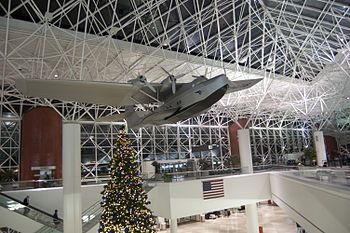Portal:Baltimore
The Baltimore Portal

Baltimore is the most populous city in the U.S. state of Maryland. With a population of 585,708 at the 2020 census, it is the 30th-most populous US city. Baltimore was designated as an independent city by the Constitution of Maryland in 1851. It is the most populous independent city in the nation. As of 2020[update], the population of the Baltimore metropolitan area was 2,838,327, the 20th-largest metropolitan area in the country. The city is also part of the Washington–Baltimore combined statistical area (CSA), which had a 2020 population of 9,973,383, the third-largest in the country. Though Baltimore is not located within or under the administrative jurisdiction of any county in the state, it is part of the central Maryland region, together with the surrounding county that shares its name.
The land that is present-day Baltimore was used as hunting ground by Paleo-Indians. In the early 1600s, the Susquehannock began to hunt there. People from the Province of Maryland established the Port of Baltimore in 1706 to support the tobacco trade with Europe, and established the Town of Baltimore in 1729. During the American Revolutionary War, the Second Continental Congress, fleeing Philadelphia prior to its fall to British troops, moved their deliberations to Henry Fite House on West Baltimore Street from December 1776, to February 1777, permitting Baltimore to serve briefly as the nation's capital, before it returned to Philadelphia in March 1777. The Battle of Baltimore was pivotal during the War of 1812, culminating in the failed British bombardment of Fort McHenry, during which Francis Scott Key wrote a poem that would become "The Star-Spangled Banner", designated as the national anthem in 1931. During the Pratt Street Riot of 1861, the city was the site of some of the earliest violence associated with the American Civil War. (Full article...)
Selected article -
On April 12, 2015, Freddie Carlos Gray Jr., a 25-year-old African American, was arrested by the Baltimore Police Department for possession of a knife. While in police custody, Gray sustained fatal injuries and was taken to the R Adams Cowley Shock Trauma Center. Gray's death on April 19, 2015, was ascribed to injuries to his cervical spinal cord.
Pending an investigation of the incident, six Baltimore police officers were suspended. Commissioner Anthony W. Batts reported that officers had not secured Gray inside the van while driving to the police station, contrary to a policy that had been put into effect six days prior to Gray's arrest. The medical examiner's office concluded that Gray's death could not be ruled an accident, and was instead a homicide, because officers failed to follow safety procedures. Baltimore City State's Attorney, Marilyn Mosby announced her office had filed charges against six police officers after the medical examiner's report ruled Gray's death a homicide. (Full article...)
Selected picture -

International terminal at Baltimore–Washington International Airport
Categories
WikiProjects
Selected biography -

John William Beschter SJ (born Johann Wilhelm Beschter; German: [ˈjoːhan ˈvɪlhɛlm ˈbɛʃtɐ]; May 20, 1763 – January 6, 1842) was a Catholic priest and Jesuit from the Duchy of Luxembourg in the Austrian Netherlands. He emigrated to the United States as a missionary in 1807, where he ministered in rural Pennsylvania and Maryland. Beschter was the last Jesuit pastor of St. Mary's Church in Lancaster, as well as the pastor of St. John the Evangelist Church in Baltimore, Maryland. He was also a priest at several other German-speaking churches in Pennsylvania.
Beschter's ministerial work was punctuated by a time as master of novices at the new Jesuit novitiate at White Marsh Manor, as well as a brief term as president of Georgetown College in 1829. While in Maryland, he aligned himself with the Continental European Jesuits in the United States, who endorsed a monarchist view of ecclesiastical leadership. After his presidency, Beschter remained at Georgetown for a year as a professor of German, before returning to Paradise, Pennsylvania, where he lived out the last twelve years of his life as a priest. (Full article...)
Did you know...
- ... that one Baltimore Orioles player compared the 2024 Major League Baseball jerseys to knockoffs from TJ Maxx?
- ... that one of the items on display at the Baltimore Museum and Gallery of Fine Arts was George Washington's shaving brush?
- ... that Darryl De Sousa created a Baltimore Police Department unit to give lie detector tests to other units?
- ... that Charles J. M. Gwinn was the first state's attorney of Baltimore elected under the Maryland Constitution of 1851, which he had helped to draft?
General images -
News
No recent news
Related portals
Topics
Associated Wikimedia
The following Wikimedia Foundation sister projects provide more on this subject:
-
Commons
Free media repository -
Wikibooks
Free textbooks and manuals -
Wikidata
Free knowledge base -
Wikinews
Free-content news -
Wikiquote
Collection of quotations -
Wikisource
Free-content library -
Wikiversity
Free learning tools -
Wikivoyage
Free travel guide -
Wiktionary
Dictionary and thesaurus





















































